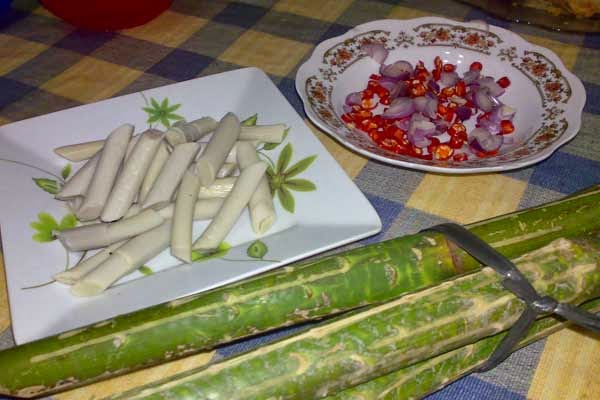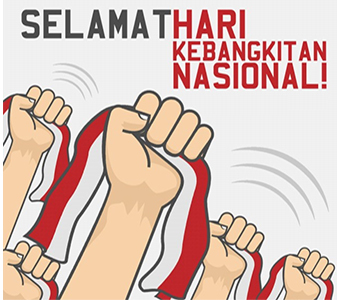Live Streaming
Program Highlight
Company Profile

nuke
May

Welcome to “Indonesian Wonder”!
During Ramadhan, every region has a typical meal that becomes the leading menu for breaking the fast. In Medan, North Sumatra, precisely in Mandailing region, rattan shoot or Pakat is a favorite menu for breaking the fast. Pakat is often served as fresh vegetables or menu complement. Pakat is a rattan shoot that has a very soft texture, so that it is easy to consume.
The taste of Pakat is somewhat bitter like other fresh vegetables in general.How to make Pakat into side dishes is quite easy. The rattan shoot is cut for one meter then roasted for half an hour by using charcoal or coconut shell stove. When it is cooked and remove the white sap, peel the outer layer then take part of the rattan fill. Cut the filling of rattan shoots for 10 centimeter. It can be consumed directly with soy sauce as fresh vegetables. Pakat can also be cooked vegetable curry with salai fish. In addition to the typical taste, the price is also quite cheap. With ten thousand rupiah, you can bring home five sticks of Pakat that have been roasted and peeled.
Pakat peddlers usually sell roasted-Pakat and provide anyang, made of coconut milk and fried coconut flesh. Order for Pakat during the holy month of Ramadan tends to increase rapidly. In addition to the Mandailing tribe, Pakat also favored by people in North Sumatra, including those the Javanese and Minang people who live in the region. They believe that Pakat can increase appetite. That's why pakat is usually consumed as menu of breaking the fast or before meal.
The bitter taste of Pakat makes other foods feel much better. Pakat is beneficial to maintain health. Pakat also believed to treat diabetes, malaria and high blood pressure. In South Tapanuli, Pakat not only used as a breaking menu, but also traditional food during special ceremonies for the people of South Tapanuli and Mandailing Natal.
Are you Interested to taste pakat? You can taste it when you visit North Sumatra during Ramadan. It's easy to find Pakat on the outskirts of the city and restaurants in Medan. For example in Jalan Karya Medan, Jalan Suka Ramai, Aksara intersection, Jalan Denai, and in several other locations.
May
DIPLOMATIC CORNER

RRI World Service -Voice of Indonesia with Diplomatic Corner
The first information is from Tanzania.
Indonesian Ambassador to Tanzania, Ratlan Pardede said that Tanzania offers investment to Indonesian companies in textile, fertilizer, infrastructure and hotel sector. Ambassador Ratlan Pardede stated in press release received in Jakarta on Friday (18/5)that Indonesia has strong desire to increase economic relations with Tanzania, especially with Simiyu province, such as in the sector of cotton, infrastructure, fertilizer, hotel and agriculture. Governor of Simiyu, Anthony Mtaka conveyed the positive response to Ambassador Ratlan. The Governor said that Simiyu is ready to encourage the existence of the investors and companies from Indonesia. The government of Simiyu is ready to provide fee land for the factory’s development. In his work visit in Simiyu, Ambassador Ratlan Pardede also had an opportunity to conduct field visit to Alliance Ginnery, the biggest cotton processing factory, and small and medium enterprises of footwear producer and chalk in Simiyu.
The second information is from Cairo, Egypt.
Indonesian government continues to explore weapon trade to Egypt and Jordan, because Indonesia has a number of State-owned enterprises which produce weapons such as PT. Pindad, PT. Dahana, and PT.
Dirgantara Indonesia. Defense attaché of the Indonesian embassy of Cairo, Egypt, Col. Kemas Muhammad Ikhwan Madani said to RRI in Cairo on Sunday (20/5) that his office has explored the weapon selling to the government of Egypt. Over the last two years, a number of representatives of PT. Pindad, PT. Dahana, and PT. DI have conducted a meeting with the government of Egypt. One of the markets which is quite big in Egypt, according to Kemas, is bullet. Even, Egyptian military have asked to be sent example of bullets of Indonesian product. The constrain is that there is no plane which wants to carry the bullet example of various kinds of the weapon. As a consequence, this cannot be realized to Egyptian military. In addition, the Indonesian government also explored cooperation with the government of Jordan to mutually produce tactical and light weapons. Thus, Memorandum of Understanding –MoU has been signed by PT. Pindad and PT. King Abdullah Design and Development Biro recently and this was witnessed by Indonesian Defense Minister, Ryamizard Ryacudu.
We end Diplomatic Corner with the information from Moscow, Russia.
ASEAN member countries and Russia agreed to strengthen cooperation to eradicate terrorism. Director of External Cooperation of ASEAN, Foreign Affairs Ministry, Benny YP Siahaan when representing the Indonesian government on the 15th ASEAN-Russia Senior Officials' Meeting said in Moscow, Russia on Friday (18/5) that eradicating terrorism cannot be alone, it needs to increase cooperation and to apply comprehensive strategy. In the meeting, ASEAN member countries and Russia conveyed condolences to Indonesia on terrorism acts which occurred in several cities in Indonesia recently. The terrorism acts became a sign that terrorism threat in the region is still real, serious and its prevention needs intensive cooperation among the countries, including ASEAN-Russian cooperation. Indonesia does appreciate Russian commitment in the cooperation to eradicate terrorism and other transnational crimes through various cooperation mechanisms of ASEAN.
May
Miscellany

RRI World Service, Voice of Indonesia, with Miscellany. This edition will be on National Awakening Day 2018.
May 20th in Indonesia is celebrated as National Awakening Day which is the date of the founding of Budi Utomo movement in Yogyakarta in 1908. The commemoration of National Awakening Day was first held on May 20, 1948 in Yogyakarta and in other areas.
Ministry of Communication and Informatics (Kemenkominfo) RI The ministry of held a series of activities on the National Awakening Day 2018 at Jalan Sudirman, Yogyakarta on Sunday, May 13, 2018themed Human Resource Development Strengthening National Awakening Foundation in the Digital Age. Expert Staff to Minister of Communication and Media Communication Minister Gun Gun Siswadi said that through this activity, his office wants to increase human resources capacity especially for the young generation. This activity also aims to raise awareness of the younger generation as the largest digital user in Indonesia to rise and utilize the technology as well as possible.Gun Siswadi added the inability to take advantage of technological progress is certainly a disadvantage. On the occasion, several activities were organized from the Human Resource Development Campaign to Strengthen National Awakening Foundation in the Digital Age, such as Fun Walk, Mass aerobics and others.
Meanwhile, the Minister of Communication and Information Technology Rudiantara invites the community to interpret the National Awakening Day this time with the movement against hoaks and negative content, as well as using domestically-made applications. Menkominfo said in a series of Car Free Day activities for the commemoration of the 110th National Awakening Day at Sarinah Parking Square, Jakarta, Sunday, May 13, 2018. The Minister also invites the community to reduce negative content in social media. also advised not to load pictures and photos that are not feasible social media, especially children. According to Rudiantara, if necessary, the public can file a direct complaint to the social media providers that disseminate such inappropriate content. It is done for a better Indonesia. Menkominfo appealed to people to use the application made by the nation. The use of national application made by the nation will make the application develop.
The peak of 110th anniversary of National Awakening Day 2018 will be held on May 21, 2018. In addition to flag ceremonies, there are also a number of activities, including Seminar and Interactive Dialogue, a visit to Heroes Cemetery, Speech Contest and many others The 2018 Harkitnas warning series is held simultaneously in three cities, namely Jakarta, Yogyakarta and Surabaya.
May
Highlight of the week

Welcome back to this Week Spotlight Highlight which today took is on "President Approves Joint Special Operations Command"
Terrorist attacks have not stopped since the riot occurred at the Salemba Detention Center of Brimob Corps Headquarters, Kelapa Dua Depok, two weeks ago. Facing this, Head of the Office of Presidential Staff, Moeldoko stated that President Joko Widodo-Jokowi has approved to revive the Joint Operation Command. With the enlargement of this special military force, the apparatus involved in overcoming terrorism include not only the Police through Densus 88 but also the Military with the Joint Special Operations Command..
Moeldoko asserted that the capability of the Combined Special Operations Command forces has also been well prepared to be assigned to various regions in Indonesia. Furthermore, the Chief of Police and Commander of TNI will further discuss the task of special forces.
The Joint Special Operation Command was formed while Moeldoko while was serving as TNI Commander and was inaugurated in June 2015. The elite force is the best combination of personnel from the Military special forces to eradicate terrorism. Among them, Unit 81 Gulfor Command Forces Kusus-Koppassus TNI army. Detachment Jala Mengkara Marine Corps Navy, and Unit Bravo Troops Typical Air ForceTNI.
It consisted of 90 specially trained soldiers in handling terrorism. The special unit was frozen some time ago.
According to Moeldoko to reactivate this special force does not require a legal umbrella. He said the joint operation needs to be run as a preventive measure against the threat of terrorism attacks and create peace of mind. He hopes the Joint Special Operations Command can be kept alive to combat terrorism and other war operations in different regions. The reinstatement of the Joint Special Operations Command is expected to provide optimal strength for securing the country.
Related to the plan, Head of Public Relations Division of the Police, Inspector General Setyo Wasisto said, the Police have coordinated with several other institutions in counterterrorism action. Among others is with TNI. Kopassus Special Forces Command. In searching or raiding activities, according to Setyo, Brimob Corps has often cooperated with kopassus. Similarly, in handling the security of vital objects.
In many terrorist arrest operations the Military have also been frequently involved. Setyo Wasisto asserted, the Police did not question the involvement of the TNI in counterterrorism action. The most common example is Operation Tinombala in Poso, Central Sulawesi. In counterterrorism operations in eastern Indonesia, the TNI participated in the field.

